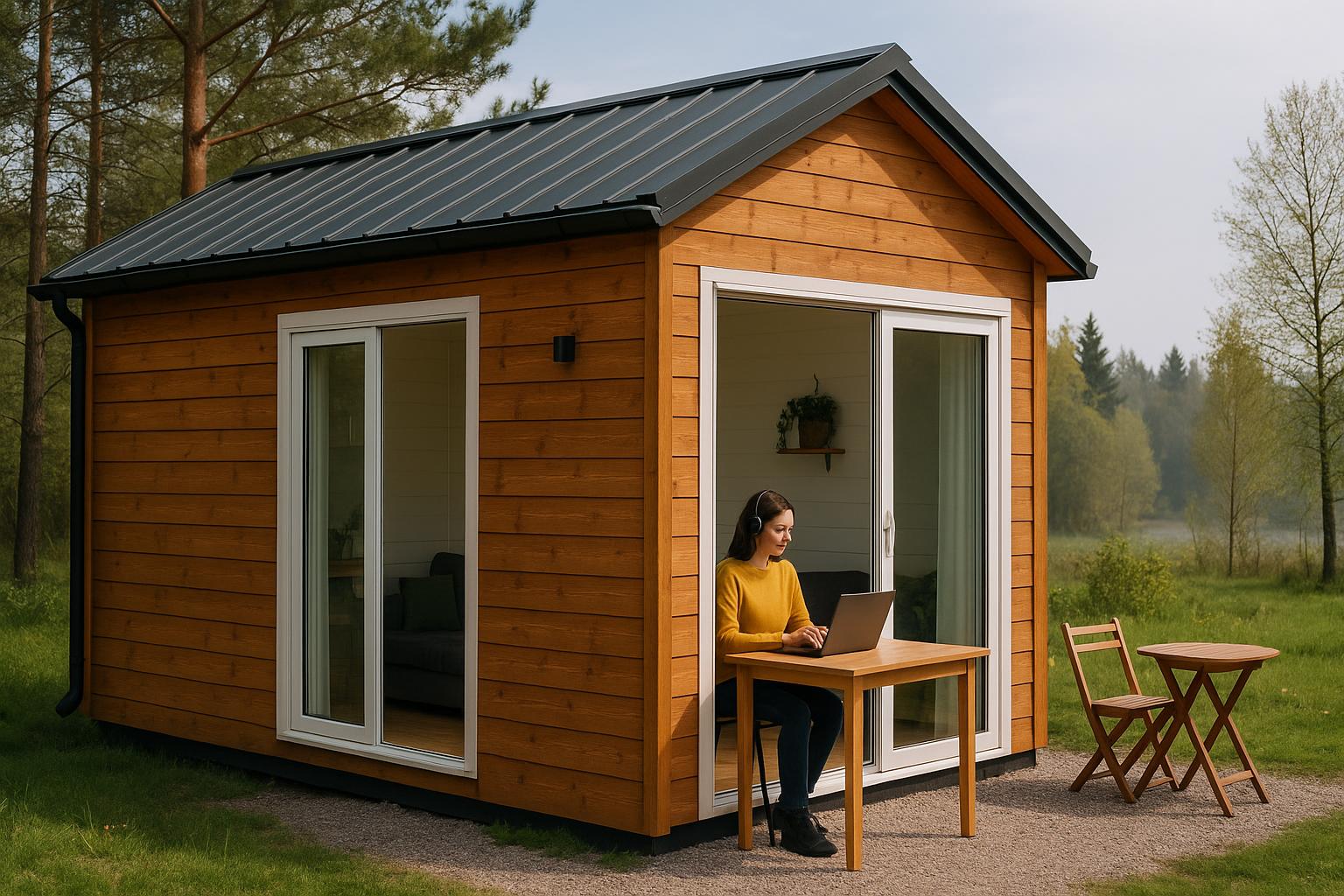
Creating a Remote Work Retreat: Transform Your ADU or Tiny Home into a Productivity Powerhouse in Canada
Estimated reading time: 10 minutes
Key Takeaways
- Purpose-Built Spaces like ADU retreats and tiny homes offer dedicated, distraction-free environments designed to boost productivity and work-life balance.
- Adaptability allows Canadians to customize small spaces with smart layouts, robust insulation, and sustainable features for year-round comfort.
- Legal & Financial Considerations are crucial when converting residences into remote work hubs, ensuring all zoning and building codes are met.
- Practical Tips including natural light enhancement, ergonomic design, and noise reduction empower home offices to thrive.
- Inspiration Across Canada from urban backyards in Toronto to forest tiny home studios in Vancouver proves that creativity can flourish in any setting.
Table of contents
- Introduction: What is a Remote Work Retreat?
- Understanding ADUs and Tiny Homes as Remote Workspaces
- Planning Your Remote Work Retreat
- Practical Tips for Maximizing Productivity
- Legal and Logistical Considerations in Canada
- Case Examples and Inspirations
- Conclusion: Unlock Your Productivity
- Frequently Asked Questions
A remote work retreat is a purpose-built space crafted for productivity, well-being, and work-life balance. It’s not just a corner office with a laptop—it’s an intentional environment where remote work, creativity, and focus truly thrive.
In 2025, the remote work trend in Canada is stronger than ever. Nearly 20% of Canadians now work remotely or in a hybrid setup—especially in cities like Toronto, Ottawa, and Vancouver. For more details on this trend, visit this source and this source.
Transforming an Accessory Dwelling Unit (ADU retreat) or a tiny home into a dedicated remote work hub is an innovative solution that brings the benefits of a professional office right to your doorstep—with cost efficiency and a significantly shorter “commute.”
Understanding ADUs and Tiny Homes as Remote Workspaces
What Is an ADU Retreat?
An ADU (Accessory Dwelling Unit) is a self-contained secondary housing unit built on the same lot as a main house. In Canada, ADUs are often called garden suites, backyard suites, laneway homes, or converted garages. Their private, independent nature makes them perfect as an ADU retreat—a secluded workspace away from everyday household distractions.
For more details on the types, benefits, and zoning specifics in Canada, check out Types of ADUs: A Comprehensive Guide to Coach Houses, Laneway Suites, Secondary Suites, and Backyard Cottages for Canadian Homeowners.
Defining the Tiny Home Workspace
A tiny home is a compact, efficient dwelling usually under 400 square feet. Whether permanent or mobile, their reduced scale and minimal design make them ideal for fostering deep focus and minimizing distractions.
Discover more design tips and lifestyle benefits in Tiny Home Living: Your Complete Guide to Micro Homes, Sustainability, and Lifestyle Freedom.
Why ADUs and Tiny Homes Are Booming in Canada
Several factors contribute to the growing interest:
- Urban Density: Cities like Toronto, Vancouver, and Ottawa are revisiting bylaws to support secondary units that ease housing shortages.
- Housing Affordability: Utilizing available backyard space or spare land offers an affordable alternative to expensive urban markets.
- Flexible Customization: Tailor your workspace exactly to your needs, from design to layout.
For more insights, visit Tiny Home Living: The Ultimate Guide to Affordable, Sustainable, and Stylish Compact Living and Home Office Solutions: How ADU Offices and Backyard Workspaces Boost Remote Work Productivity.
Design for the Canadian Climate
In Canada, practical design choices include:
- Robust insulation and efficient heating for biting winters.
- Weatherproofing doors, windows, and roofs to ensure year-round comfort.
- Adherence to local building codes and incorporation of sustainable features such as energy-efficient lighting and insulation.
Learn more about eco-friendly designs in Tiny Sustainable Living: How Eco-Friendly Homes and Energy-Efficient Design Are Shaping the Future of Sustainable Housing.
Additional insights can be found at this resource.
Planning Your Remote Work Retreat
Transforming an ADU or tiny home into a remote work retreat requires careful planning. Start by determining your needs:
Step 1: Choosing the Right Unit for Remote Work
Assess your space needs:
- Decide if you need an office, creative studio, or multi-purpose retreat.
- Consider storage requirements and layout for your daily tasks.
- Determine if additional guest space or overnight accommodations are necessary.
ADU Retreat vs. Tiny Home:
- ADU retreat: Ideal if you have existing property in urban or suburban settings.
- Tiny home: Perfect for rural settings or if you desire portability.
Also, research legal compliance in Canada by checking local zoning laws, size restrictions, and utility requirements. For more details, refer to Canadian ADU Regulations: A Comprehensive Provincial Guide to Secondary Suites, Zoning Laws, and Building Permits.
Step 2: Smart Location and Layout for Productivity
Choosing the Right Spot:
- Natural light: Place your unit where you can maximize daylight from windows or skylights.
- Views and Privacy: Select a location that offers serene outdoor views while minimizing distractions.
- Minimal Disruption: Ensure that the placement does not negatively impact your neighbours or the environment.
Optimizing the Interior Layout:
- Open Space: Keep a clutter-free layout to make the small space feel larger and calm.
- Built-in Storage: Implement hidden cabinets and lofted areas to maximize efficiency.
- Zoned Areas: Establish dedicated zones for desk work, creative pursuits, and relaxation.
For more design ideas, visit Tiny Home Interior Trends 2025: Smart, Sustainable, and Stylish Canadian Small Space Living.
Step 3: Integrating Productivity Essentials in Your Retreat
Your retreat should incorporate elements that boost focus and efficiency:
- Let in the Light: Install large windows or skylights and use light-coloured walls to maximize natural illumination.
- Ergonomics Matter: Invest in an adjustable chair with proper lumbar support and a sit-stand desk for varied work styles.
- Soundproofing: Utilize heavy curtains, rugs, and acoustic panels to reduce ambient noise.
- Technology Essentials: Ensure high-speed internet—as highlighted by Statistics Canada—and incorporate robust power sources with backup options.
For further guidance on optimizing connectivity and tech in remote spaces, check out Best Internet for Tiny Homes in Canada: Your 2025 Guide to High-Speed Connectivity, Provider Options, and Smart Home Requirements.
Step 4: Customization and Inspiration for Your Workspace
Personalize your workspace to reflect your style and boost your creativity:
- Inspiring Decor: Choose calming or energizing paint colours and add living plants to improve air quality.
- Maximize Outdoor Connection: Position seating to face windows that offer garden or natural views.
- Flexible Features: Use movable furniture and convertible zones to adapt your space as needed.
For creative living solutions, visit Pet-Friendly Design for Canadian ADUs and Tiny Homes: Creative Solutions for Comfortable and Functional Compact Living.
Practical Tips for Maximizing Productivity in Your ADU or Tiny Home Retreat
Build Structured Daily Routines
- Set regular start and finish times to establish clear work boundaries.
- Plan dedicated break periods for stretching, hydration, and fresh air.
- Block time for deep work to focus on high-priority tasks.
Stay on Top of Your Tech
- Ensure your internet is fast and reliable; consider backup solutions for rural settings.
- Use surge protectors and maintain up-to-date equipment to avoid interruptions.
Minimize Distractions in Small Spaces
- Invest in noise-cancelling headphones and visual cues to establish work zones.
- Keep supplies and personal items organized to reduce clutter and distractions.
Work-Life Balance Matters
- Create a mini “commute” by physically walking to your ADU or tiny home each day.
- Establish a ritual to signal the end of your workday, helping to transition back to personal time.
Legal and Logistical Considerations in Canada
Permits, Zoning, and Local Regulations
- ADU and tiny home guidelines vary city by city and province by province.
- Check with your local municipality regarding zoning laws, permitted uses, and size restrictions.
- Some locales have appearance guidelines or setback requirements.
For a detailed guide on this topic, see Navigating ADU Permits in Canadian Cities: A Complete Guide to Zoning Laws, Legal Requirements, and the Building Process.
Building Code and Safety
- Ensure your unit meets Canadian safety standards for insulation, wiring, heating, and emergency exits.
- Professional inspections may be required for occupancy permits.
Budgeting and Financing Your Retreat
- Costs can range significantly based on size, materials, and finishes.
- Consider financing options like personal savings, HELOCs, or potentially available grants and rebates.
For financial guidance, refer to The Ultimate Guide to ADU Financing Canada: How Homeowners Can Successfully Fund Secondary Suites and Access Loans, Grants, and Tax Credits.
For additional insights, visit this resource.
Case Examples and Inspirations: Canadian Remote Work Retreats in Action
Toronto: Backyard ADU Office, Winter-Ready
Sarah, a marketing consultant in Toronto, converted her detached garage into a fully insulated ADU office. With triple-pane windows for natural light and minimalist Scandinavian design, she created a workspace that protects her from cold, dark winters and boosts her productivity.
Design inspiration: Large windows, built-in shelving, modern LED lighting, and eco-friendly insulation. For more ideas, check out HGTV Canada’s small space makeovers.
British Columbia: Forest Tiny Home turned Creative Studio
James, a freelance designer from Vancouver, transformed a 300-square-foot tiny home into a creative studio. With skylights, recycled wood finishes, and solar panels, he now enjoys an eco-friendly workspace that fuels his creativity.
Design inspiration: Scandinavian minimalism paired with vibrant accent art. Find more ideas at Tiny House Talk Canadian Tours.
Additional examples include forested ADU retreats on Vancouver Island, modular home offices in Calgary, and modern tiny home offices in Ottawa—all showcasing unique solutions for every climate and work style.
For further inspiration, visit Canadian Living ADU Projects.
Conclusion: Unlock Your Productivity with a Canadian Remote Work Retreat
Creating a dedicated remote work retreat in an ADU or tiny home offers enhanced privacy, a customized workspace, and a distinct separation between home and work life. This clear demarcation not only boosts productivity but also fosters well-being and a balanced lifestyle across Canada.
With the rise of remote work—highlighted by trends in remote/hybrid work policies and working from home statistics—there’s never been a better time to invest in transforming your space. Whether it’s an ADU retreat or a tiny home workspace, the right environment can make all the difference.
For further inspiration on combining home office design with ADU innovation, explore Transform Your Work Life: Creating an Ideal Home Office with ADU Offices and Backyard Workspaces.
Frequently Asked Questions
Can any property be converted into an ADU retreat or tiny home workspace?
Conversion depends on local zoning laws and building codes. It is important to check with your municipality to ensure compliance with all requirements.
How do I manage insulation and heating during harsh Canadian winters?
Use robust insulation, energy-efficient heating systems, and weatherproofing measures to ensure a comfortable environment all year round.
What financing options are available for converting or building a remote work retreat?
Many homeowners utilize personal savings, home equity lines of credit (HELOC), or special grants and rebates available in some regions. It’s beneficial to consult with local lenders and financial advisors to explore your options.

Leave a Reply